Operating Theatre
Interior view of amphitheater with a table for dissection situated beneath a can[d]elabrum; two men are standing to the right in consultation; flanking the amphitheater are two statues, on the right is Aesculapius with caduceus, left is Hermes(?)¶. {undated, artist not named; ?probably late 17th/early 18th cent.}¶More likely Apollo (see comments).
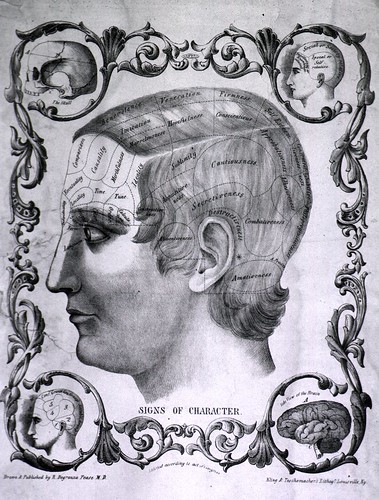
Signs of Character
Drawn and Published by R. Degranza Pease M.D. 1843Phrenology poster which shows a profile with labeled sections in an elaborate border.
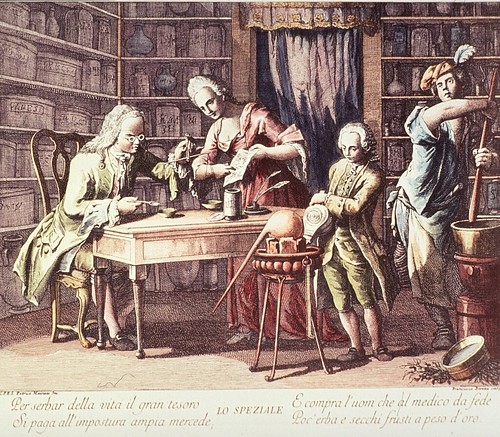
Apotheke, Lo Speziale
Interior view showing the production of pharmaceuticals.Color reproduction of an engraving by Franciscus Baretta after a work by Petrus Mainoto (18th cent.)
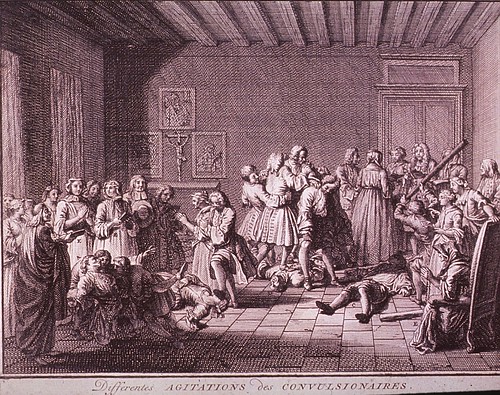
Differentes Agitations de Convulsionaires
Artist: Bernard Picart (Picard), 1736.
Interior scene: a religious service (exorcism?) is in progress; a large group of people are reading and praying; some (perhaps bewitched) exhibit states of hysteria; one man is bludgeoning another; religious iconography hangs over an alter in background.Artist: Bernard Picart (Picard), 1736.

E Per Natura E Per Amor Sorelle
Titlepage vignette from 'La Costituzione Corrente Brevemente Considerata' by Pietro Orteschi, 1762.Laying on the ground is a caduceus on top of which is a T-square, a barometer, and a thermometer; perched on top of everything is a rooster.
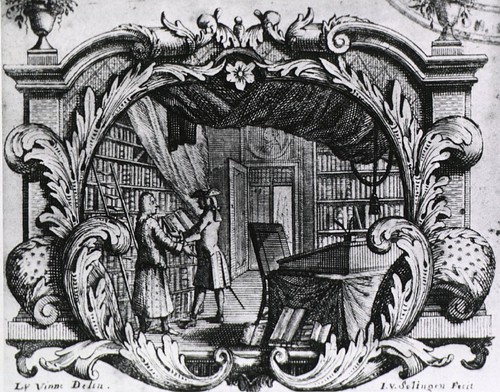
Early 18th century library
IN: 'Bibliographiae Anatomicae Specimen' by James Douglas, 1734.Interior view of a library through a garlanded opening; a man has received assistance in retrieving a book, he stands holding the open book before him; another man is standing next to a ladder that is leaning against the shelves.
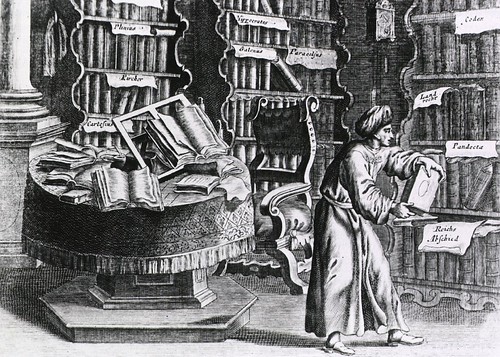
Early medical library
IN: 'Oeconomus Prudens et Legalis' by Franciscus Philippus Florinus, 1722.Interior view of early 18th century medical library showing the arrangement of text by author, also indicated are those authors considered important. A large table with several open books on it fills the foreground; a man is returning a book to a shelf.
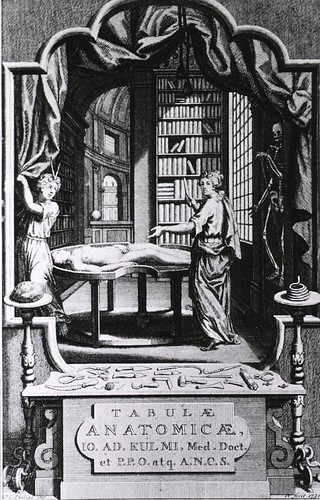
The Human Body and the Library as Sources of Knowledge
Fronispiece in 'Tabulae Anatomicae' by Johann Adam Kulmus (early 18th cent.)Interior view of a library with allegorical figures; a body rests on a dissections table in center; a skeleton stands in an alcove to the right; surgical instruments are arranged on a pedestal in the foreground; bookshelves fill the background.
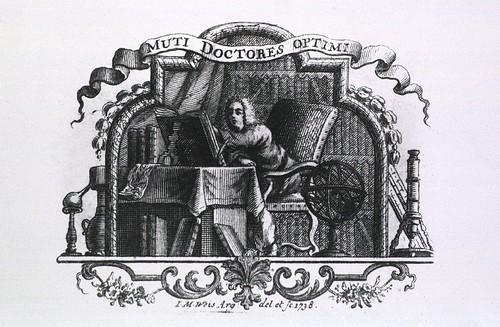
Muti Doctores Optimi
{title page vignette} IN: 'Lexicon Physico-Chymico-medi cum Reale' by GH Behr, 1738.A man is reading a large book propped up on a table; bookshelves fill the background, and a few pieces of scientific equipment are strategically placed.
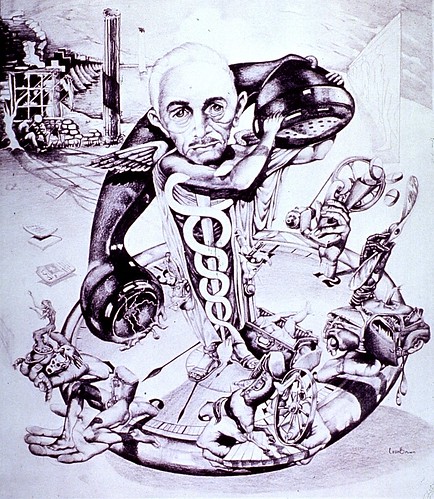
The General Practioner by Leon Brown, 1950s
Surrealistic representation of a physician with a caduceus body, a telephone receiver over his shoulder, and standing on a time piece with human hands at the hours holding representations of procedures performed by general practioners.
The Anatomist by Leonard Baskin (20th cent.)
Half-length figure of a man holding a model of a skeleton; partial anatomical chart to the right.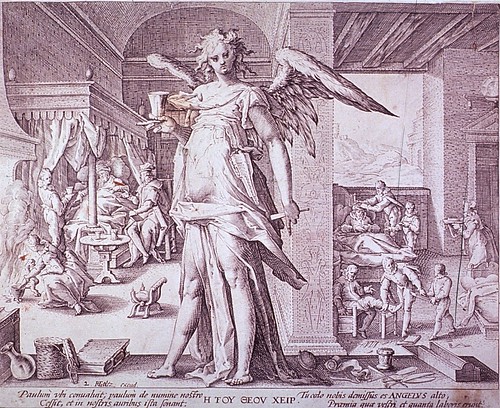
The Physician as an Angel
Allegorical figure of the physician as an Angel standing among books and tools of the medical professions. Interior scene: two views of patients in bed consulting with physicians; splint being replaced on broken leg; woman with small pot at fireplace. [by Hendrik Goltzius, about 1600]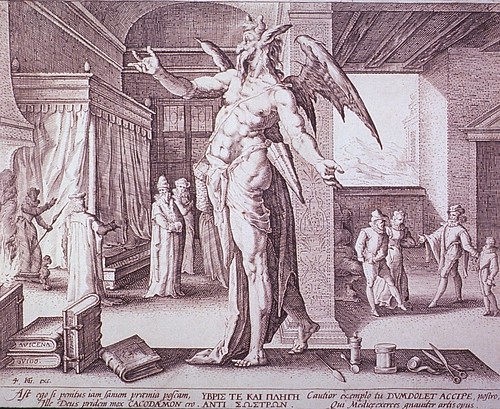
The Physician as the Devil
Allegorical figure of the physician as the devil standing among books and tools of the medical professions. Interior view, two scenes: the patients have recovered fully and the physician has come to collect his fee. [by Hendrik Goltzius, about 1600]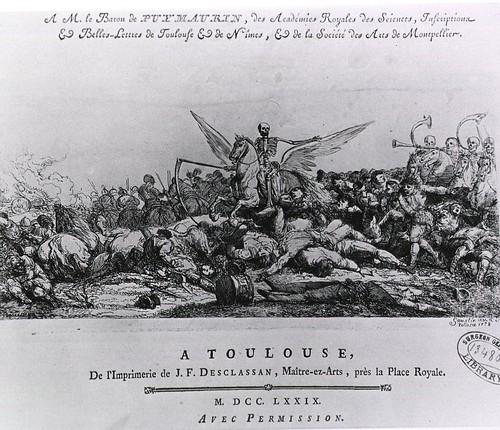
Death, riding Pegasus, is Leading Troops into Battle
IN: 'Nouveau Recueil d'Osteologie et de Myologie' by Jacques Gamelin (late 18th cent.)Title page vignette of battlefield scene: a skeleton, carrying scythe and riding winged horse through a throng of dead or dying bodies, motions to other skeletons on horseback (at right) to follow.
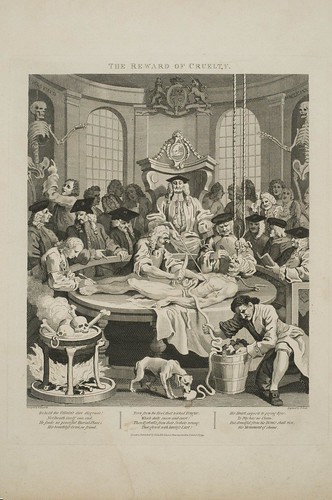
The Reward Of Cruelty
Design'd by William Hogarth; Engrav'd by T. Cook. (The Four Stages of Cruelty; 4)A cadaver is being dissected in an anatomical theatre. 1751 [in colour]
Behold the villain's dire disgrace!
Not death itself can end.
He finds no peaceful Burial-Place,
His breathless cor[p]se, no friend.
Torn from the Root that wicked Tongue,
Which daily swore and curst;
These Eyeballs from their Sockets wrung
That glow'd with lawless Lust!
His Heart exposed to prying Eyes,
To Pity has no Claim:
But, dreadful from his Bones shall rise,
His monument of shame.
The Images from the History of Medicine database of nearly 70,000 book illustrations, photographs, prints and posters at the National Library of Medicine has been revamped to include enhanced searching and viewing capabilities.
They now include What, Where and Who directories and, for instance, the above images were selected from Books in Art, Emblems and Insignias and Phrenology categories (among others). The server seems a touch slow but not too bad.
[Announcement; via] Virtually all the captions are quoted from the source site




















9 comments :
I'm tempted to speculate whether the image from E Per Natura E Per Amor Sorelle above, refers to the health of the male reproductive organ?
Your blog rocks.
The statue on the top right is almost certainly Apollo, usually depicted with a lyre but also recognized as the god of archery and medicine.
...should be: top left, of course.
Does anyone have any idea where I might find a print of the "Signs of Character" poster or a file large enough to print myself? I want one to put in my house.
I'm tempted to say they're very entertaining, but that seems a bit inappropriate re convulsionaries being bludgeoned.
Kittybriton, you are worse than I am. I know I've seen that snake-and-cockerel combination before, though. (Who knows where...)
Oh... the gist of my emailed answer to Josh is that "I don't know" where to get a printable quality version of the phrenology pic; although I suspect that the style has a healthy residual popularity at poster/print/map/artsy shops. Anyone seen anything like it?
And Jos, you may well be right. The question mark after "Hermes" was quoted from the NLM site and was not mine. I didn't check it out.
Josh Miley: If you do a Google search for "phrenology poster" you might be able to track it down, or at least find similar posters (like this one: http://www.zazzle.co.uk/phrenology_poster-228565261664374872).
Jos is right, the figure at the top left of the first image is certainly Apollo. The original Hippocratic oath was sworn to Apollo, among a few other deities.
Post a Comment
Comments are all moderated so don't waste your time spamming: they will never show up.
If you include ANY links that aren't pertinent to the blog post or discussion they will be deleted and a rash will break out in your underwear.
Also: please play the ball and not the person.
Note: only a member of this blog may post a comment.